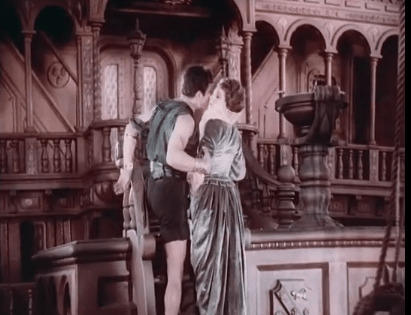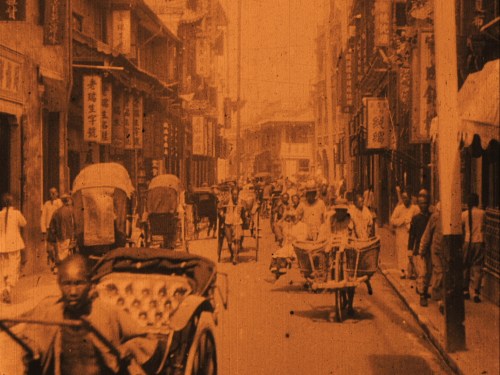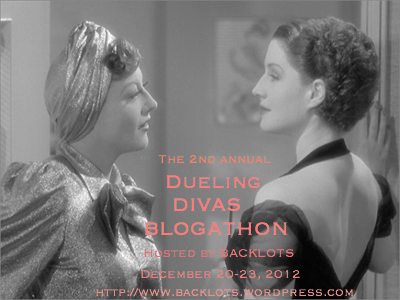
Yesterday afternoon at the Castro Theatre in San Francisco, the San Francisco Silent Film Festival hosted its annual Day of Silents, featuring a magnificent lineup of silent films from around the world that whet the festivalgoer’s appetite for the larger festival taking place in June. This year’s Day of Silents included a diverse offering of films that seemed to have something for everybody.
The day started with a screening of The Black Pirate (1926), a Douglas Fairbanks mainstay and one of the first films to be shot in two-strip Technicolor. We were lucky enough to have Tracey Goessel, the author of the new Douglas Fairbanks biography The First King of Hollywood (a very solid and informative read, expect a review on the blog very soon) on hand to introduce the film, and Tracey related a few interesting anecdotes about the filming. Fairbanks’ beard made photography with primitive two-strip Technicolor a bit difficult, and they often had to stop and apply more makeup so that his face wouldn’t turn green in the Technicolor process. But sometimes they couldn’t get to his beard before the Technicolor affected his coloring, so every now and then in the film, Fairbanks’ face turns a slight shade of green.

Doug looking a bit green.
The movie stars a remarkably beautiful Billie Dove as Fairbanks’ love interest, at the height of her fame and beauty. The plot involves Doug trying to rescue her from a terrible fate, and, of course, he succeeds in the end. The final kiss between Fairbanks and Billie Dove is not between Fairbanks and Billie Dove at all–in fact, for the kissing scene, Mary Pickford was brought in and what we see is a kiss between the biggest Hollywood power couple of the 1920s.

Doug and Mary at the end of The Black Pirate.
The Black Pirate is a typical Douglas Fairbanks movie, which is to say that it thrills, delights, and incites countless moments of awe at Fairbanks’ swashbuckling acrobatics. Watching a Douglas Fairbanks movie is one of life’s particular cinematic joys, as his brand of daring stunts, achieved without a double, combined with his million-dollar smile and exuberant personality, have scarcely been matched by anyone else in all of film history. He created the prototype, and though many have tried to replicate what he does, few have succeeded. As far as I can think, the person who came closest to replicating what Douglas Fairbanks did was Errol Flynn, with his damsel-in-distress, swordfighting onscreen persona. But even he, with his slight build and boyish face, lacks the unique charisma of the suavely charming, almost sassy Fairbanks.
If you haven’t seen The Black Pirate, the complete film is available to watch on youtube. I highly recommend it.
Some other highlights of the festival included a beautiful series of home movies filmed in China between 1900 and 1948, and a showing of Houdini’s 1919 film The Grim Game. The Grim Game feels almost like a filmed magic show, as the entire plot of the film didn’t matter so much–it was a show piece for Houdini’s talents. The audience laughed with delight when Houdini’s character was in jail and locked up in chains–replicating the famous photo of the magician.

There was also a subplot that led up to the inevitable famous trick of Houdini escaping from a straitjacket while hanging upside down from a building. Again, the audience knew exactly what was coming, and muttered among themselves knowingly when Houdini had his straitjacket put on.
The Grim Game was recently restored and shown at the TCM Classic Film Festival in Hollywood, and since then has been making the rounds at several festivals around the country. It is a must-see for Houdini fans and anyone interested in magic, as there are some truly remarkable feats accomplished by Houdini in the film.
The home movies around China were simply breathtaking. Shot by a wide variety of amateur filmmakers, they showed the different provinces of China over a nearly 50-year span, marking the significant historical and social changes that the country went through. In the movies filmed around 1900, we saw nearly everyone in traditional Chinese dress, surrounded by wooden buildings and shops bearing names written only in Chinese characters. By 1915, we were beginning to see evidence of American and European trade and influence, with European men and women riding bicycles through the streets and shop signs transliterated into Latin lettering. By 1930, people had begun to adopt western-style clothing in the cities, and you see the roots of industrialization that were beginning to take shape. It was a beautiful and enlightening history lesson, through the most informative lens we have–the home movie.

Beijing, 1910.
As always, the San Francisco Silent Film Festival delivers the highest quality silent film experience I have ever had the pleasure to have. I am so fortunate to be able to take part in it every year, and I hope that, if you have never been, you will be able to make it out to the larger festival in late May/early June. Stay tuned for details as it gets closer.
See you next time!



























_03.jpg)

